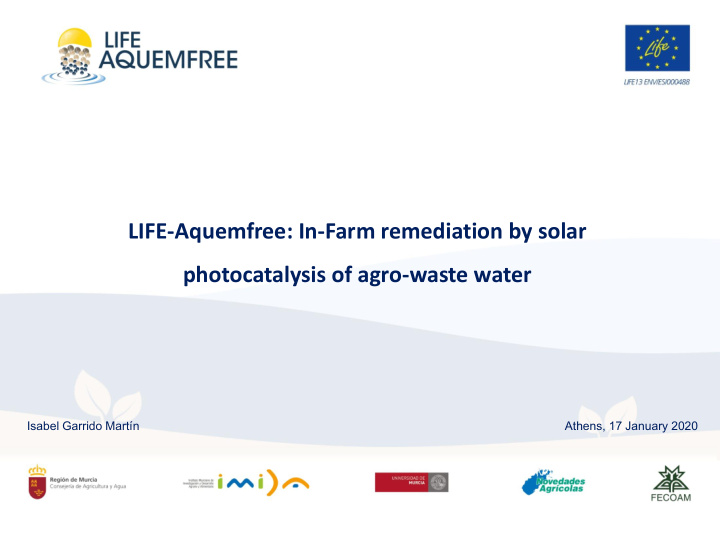



LIFE-Aquemfree: In-Farm remediation by solar photocatalysis of agro-waste water Isabel Garrido Martín Athens, 17 January 2020
The project Project ENV/ES/000488 LIFE-Aquemfree Co-ordinator: IMIDA Partners: Universidad de Murcia Novedades Agrícolas S.A. Federación de Cooperativas Agrarias de Murcia 48 months (01/07/2014 – 30/06/2018) Total budget: 1.863.566 € CE contribution: 911.356 €
Background Murcia as a pilot Region Contribution to Spanish production 25% vegetable production 60% lemon 60% table grape 50% melon 50% grapefruit 250.055 has 8.420 Tm PPP/year 90.000 m 3 waste water (360 l/ha)
Background Agro-waste water Tank rinse after treatments Treatment remnants Packaging rinse Equipment and machinery cleaning 2.5 m 3 /year Average waste water in a farm
Background Legal framework The Directive 2009/128/EC to achieve the sustainable use of pesticides obliges Member States to « … adopt the necessary measures to ensure that the operations by professional users and where applicable by distributors do not endanger human health or the environment»
Background Legal framework Operations include: • handling of packaging and remnants of pesticides • disposal of tank mixtures remaining after application • cleaning of the equipment used after application • recovery or disposal of pesticide remnants and their packaging
Background Available technologies 2012 HELIOSEC (Syngenta): The effluent is dehydrated and subsequently the waste is removed PHYTOBAC (Bayer): The effluents are decomposed in the soil naturally by the effect of microorganisms in a closed system
Background The problems to be tackled Environmental : waste water management Legal : Directive “ sustainable use of pesticides ” Technical : no complete solution available
The project Objective: 0 residue in water Demonstrate an alternative, economic and ecological technique to degrade pesticide residues contained in wastewater produced on farms by remnants in containers and treatment tanks, rinsing tanks after use, cleaning machinery and equipment, etc. with innovative equipment installed in the farms
The project One first prototype of AQUEMFREE equipment installed and running in one pilot farm. 4 pilot pieces of equipment installed and running in four commercial farms. Operation Manuals for equipment and method procedures. Technical and socio-economic viability results. Governance recommendations for public authorities, both legal and financial instruments
Conventional processes: unable to eliminate persistent pesticides (reverse osmosis, adsorption, disinfection,..) Advanced oxidation processes (AOPs): Generation of strongly reactive free radicals to react with recalcitrant organic compounds Photochemical AOPs solar or artificial light for generating ● OH Non-photochemical AOPs other types of energy for generating ● OH Non-photochemical Photochemical Ozonization in alkaline media (O 3 /HO - ) Photolysis of water in vacuum ultraviolet Ozonization with hydrogen peroxide (O 3 /H 2 O 2 ) UV/H 2 O 2 Fenton processes (Fe 2+ , Fe 3+ /H 2 O 2 ) UV/O3 Electro-oxidation UV/O 3 /H 2 O 2 Electrohydraulic discharge-ultrassound Photo-Fenton processes (Fe 2+ , Fe 3+ /H 2 O 2 /UV) Heterogeneous photocatalysis Supercritical water oxidation Catalytic wet air oxidation Sulphate radical-based
SOLAR PHOTOCATALYSIS Radicals are formed by light radiation (photons) e - + O 2 → O 2 ● - ● - + H 2 O → ● OH O 2 Organic pollutants e - Conduction band TiO 2 + h ν → h + + e - h ν Eg bangap energy Intermediate products h + Valence band h + + H 2 O → ● OH CO 2 + H 2 O + inorganic salts Photocatalyst: Semiconductor particulate material (TiO 2 , ZnO,…) • • • Photoactive Biologically and chemically inert Inexpensive • • • Able to utilize visible/UV light Photostable Non-toxic
The process 2014 2018 Termómetro Suministro eléctrico pH-metro Aire Reactivos Reactor fotoquímico Salida de Entrada de agua de agua refrigeración 1 5 Sistema de refrigeración 1 0 2 3 Lámpara 4 9 7 6 Entrada de agua de Salida de 8 refrigeración agua 59’N Núcleo de agitación 08’W Bomba Válvula de muestreo 1. Recogida de información 2. Selección de fitosanitarios a 3. Puesta a punto de la 4. Optimización de la 5. Realización de ensayos de 6. Instalación de prototipos en 4 fincas y realización 7 Análisis de resultados y 8. Emisión de informes y 4. Optimization at 1. Ex-ante analysis and 2. Selection of phytosanitary 3. Fine-tuning of 5. Essays at field scale in 6. Prototypes installed in 4 farms and essays 7. Analysis of results and socio- 8. Reporting and en explotaciones agrícolas y estudiar metodología analítica técnica a nivel de campo en planta piloto de ensayos en condiciones reales evaluación socio-económica publicación de resultados laboratory scale selection of pilot farms products analytical metodology pilot plant performed in real conditions economic assessment dissemination of results selección de fincas laboratorio
The farms Preparatory Actions → Torre Blanca (experimental) → Los Rizaos: (peppers, artichokes, lettuces...) → Cabezo Grande: (tomatoes, watermelon,..) → Los Buitragos: (citrus trees) → La Deseada: (stone fruit trees) La Deseada farm Los Buitragos farm Los Rizaos farm Torre Blanca farm Cabezo Grande farm
Preparatory Actions Optimisation of the photocatalytic process PPPs: 42 Photocatalysers: TiO 2 and ZnO Results: High degradation levels
Recommend
More recommend